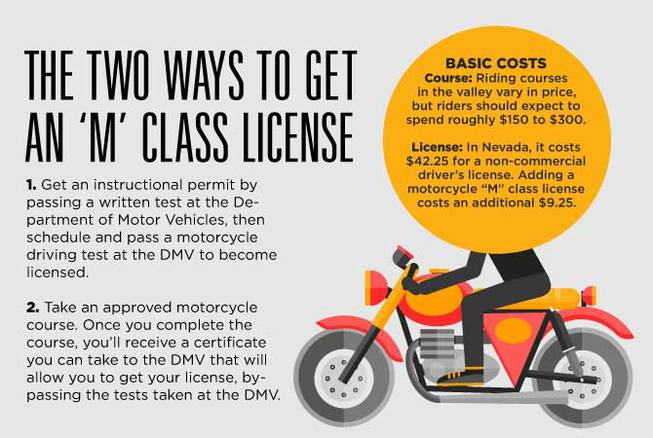
Sunday, July 19, 2015 | 2 a.m.
In 2014, the victims in more than 18 percent of Nevada’s road fatalities were motorcyclists. While an alarming statistic, more motorcycle training and knowledge can help reduce that number. Resources such as motorcycle classes cover everything from riding laws and basic operation to how to make important judgment calls during complicated driving situations.
Whether you’re a first-time rider hoping to get your license or you’ve been riding for years, motorcycle training classes can help polish and hone your skills — and maybe even give you a break on your insurance premium.
Two ways to get your motorcycle (“M” class) license
1. Get an instructional permit by passing a written test at the Department of Motor Vehicles, then schedule and pass a motorcycle driving test at the DMV to become licensed.
2. Take an approved motorcycle course. Once you complete the course, you’ll receive a certificate you can take to the DMV that will allow you to get your license, bypassing the tests taken at the DMV.
What to expect at motorcycle school
The Motorcycle Safety Foundation provides the curriculum used in Nevada for the Basic Rider Course, which teaches motorcycle fundamentals. The course typically is taught over a two-and-a-half-day period and includes both classroom time and riding practice.
What you’ll learn in the classroom
Basic costs
Course: Riding courses in the valley vary in price, but riders should expect to spend roughly $150 to $300.
License: In Nevada, it costs $42.25 for a non-commercial driver’s license. Adding a motorcycle “M” class license costs an additional $9.25.
Learn about different types of motorcycles and the layout and operation of basic controls. Take part in activities that introduce the mental and perceptual processes needed to be a good rider. The activities are designed to show you how to process information and make safe decisions while riding.
What you’ll learn on the motorcycle
Practice basic controls including using the clutch and throttle coordination; straight-line riding; and stopping, turning and shifting. Instruction also will cover swerving, emergency braking and curves. The course concludes with both a written test and a riding evaluation. The curriculum for the riding portion can be broken down into 14 categories.
1. Becoming familiar with the motorcycle including basic functions of the major parts, identifying the main controls and learning how to hold your body while riding and dismounting
2. Using the “friction zone,” a maneuver using the clutch that allows you to ride in a smooth, controlled manner while stopping, starting and changing gears
3. Drills to learn how to properly start and stop with precision
4. Learning how to shift and stop
5. Practicing basic skills including low-speed maneuvering around bends and corners
6. Initiating and adjusting lean while maneuvering curves, including how to use handgrip pressure and handlebar movement
7. Stopping quickly and making tight turns from a stop, including how to brake progressively to avoid skidding
8. Demonstrating stopping distance, allowing students to observe the total stopping distance needed and illustrating the effects of speed on braking distance
9. Maneuvering the motorcycle in limited spaces
10. Learning how to stop on curves including traction management
11. Judging and negotiating curves
12. Maneuvering multiple curves and learning how to change lanes, including learning how to judge safety margins and gap selections while changing lanes
13. Avoiding obstacles and swerving safely, including techniques for crossing over obstacles and practicing weaving at low speeds
14. Combined skill practice using a series of learned maneuvers

Join the Discussion:
Check this out for a full explanation of our conversion to the LiveFyre commenting system and instructions on how to sign up for an account.
Full comments policy